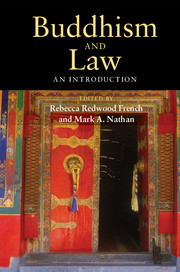Book contents
- Frontmatter
- Dedication
- Contents
- Maps and Illustrations
- Contributors
- Preface
- Abbreviations
- Introducing Buddhism and Law
- Part I The Roots of Buddhism and Law in India
- Part II Buddhism and Law in South and Southeast Asia
- Part III Buddhism and Law in East Asia
- Part IV Buddhism and Law in North Asia and the Himalayan Region
- 17 Buddhism and Law in Tibet
- 18 Buddhist Laws in Mongolia
- 19 Karma, Monastic Law, and Gender Justice
- 20 Buddhism and Constitutions in Bhutan
- A Selection of Readings
- Index
- References
17 - Buddhism and Law in Tibet
Published online by Cambridge University Press: 05 August 2014
- Frontmatter
- Dedication
- Contents
- Maps and Illustrations
- Contributors
- Preface
- Abbreviations
- Introducing Buddhism and Law
- Part I The Roots of Buddhism and Law in India
- Part II Buddhism and Law in South and Southeast Asia
- Part III Buddhism and Law in East Asia
- Part IV Buddhism and Law in North Asia and the Himalayan Region
- 17 Buddhism and Law in Tibet
- 18 Buddhist Laws in Mongolia
- 19 Karma, Monastic Law, and Gender Justice
- 20 Buddhism and Constitutions in Bhutan
- A Selection of Readings
- Index
- References
Summary
The Tibetan plateau is an immense high-altitude desert that, except for a few larger towns, was very sparsely populated with agriculturalists, nomadic herders, and merchant traders prior to 1960. The small population and minimal urbanization are the most important distinguishing features of this Buddhist country because concentrated populations are commonly connected to the development of government administration, law, and intellectual production. Despite this, Tibetan culture is known for its long history of enormous production of literary, scholarly, and religious works. Books on Buddhism and other topics from the five traditional classifications of knowledge in Tibet – arts and crafts, medicine, language, logic and Buddhism – were written and printed throughout much of Tibetan history.
When discussing the relationship between law and Buddhism in Tibet, the number of topics and the many historical twists and turns are daunting given the long history, the growth in Tibetan scholarship, and the rich textual resources available. As it is not possible to cover all of Tibetan legal history, this essay will concentrate on four distinct periods, providing a brief political history followed by a discussion of law during each period: (1) the Empire period (c. 600–850), which is the origin of many of the original customary law practices that were codified over the centuries; (2) the First Patron-Priest period (c. 1264–1350) in which a particular political formation, “the patron-priest,” resulted in the interweaving of Buddhist principles with legal and political institutions into a “Buddhist government”; (3) the Law Code Drafting period (c. 1618–1705) in which the law codes were developed and took on a very specific form and shape that included Buddhist elements in the prologue, factoring, and forms of reasoning; and (4) the 1940s in Tibet, the period before the Chinese takeover, in which we can look at the daily practice of law as it blends ordinary bureaucratic decision-making with a continuous thread of customary practices from early times and embedded Buddhist concepts.
- Type
- Chapter
- Information
- Buddhism and LawAn Introduction, pp. 305 - 318Publisher: Cambridge University PressPrint publication year: 2014
References
- 1
- Cited by



